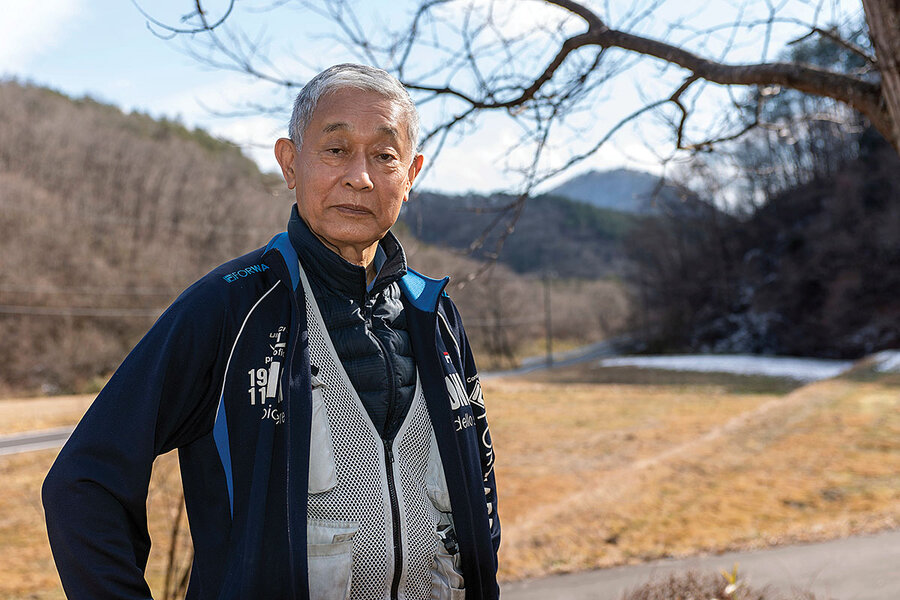Why Japan still plugs into nuclear
Loading...
| Iitate, Japan
News reports of a magnitude 7.3 earthquake that struck off the coast of Fukushima prefecture just a few weeks ago, on Feb. 13, contained the usual details. They cataloged the number of injuries, power outages, transportation disruptions – and, crucially, the situation at Japan’s nuclear reactors. The tremor was, after all, the biggest to hit Japan since 2011, when a megaquake set off a deadly tsunami that caused the meltdown of three reactors at the Fukushima Daiichi nuclear complex.
Small amounts of radiated water were, in fact, spilled at the plant by the recent earthquake, but there was no radiation leak, according to the facility’s operator, Tokyo Electric Power Co. (Tepco). Nevertheless, it was a reminder of the potential risks of harnessing the power of the atom to generate electricity in one of the most seismically active countries in the world.
Ten years after the Fukushima accident, the worst since Chernobyl in 1986, the decommissioning process in Japan is progressing but will still take another three to four decades before all the reactors at the site are fully dismantled. Yet with the need to curb global warming becoming more urgent, and renewables not yet capable of meeting all energy demands, nuclear power is still being embraced as a crucial part of Japan’s – and the world’s – future energy mix.
While many nuclear plants in Japan remain shut down for safety improvements, other reactors are scheduled to come on line in the years ahead. Many energy analysts – and even some environmental groups – see nuclear power as the best “bridge fuel” to a green energy future.
Before the meltdowns at Fukushima, 54 reactors were operating in Japan, and a handful more were at various stages of planning and construction. Of those, 33 have been designated as operable 10 years later, though only four are actually on line. Regulations introduced after Fukushima stipulate more stringent safety measures and the need for local community approval for restarts, the latter proving to be the higher hurdle. The cost of enhancing safety at the remaining operable reactors and decommissioning the rest is estimated at $128 billion.
Tepco officials say work is moving ahead at the Fukushima plant but concede it’s an arduous process. “The work environment has been improved to the point where workers only need to wear normal face masks and uniforms in approximately 96% of the site,” says Tepco’s Ryounosuke Takanori. “As we engage in this unprecedented task, we shall continue to prioritize safety and fulfill our responsibility to complete the lengthy decommissioning process.”
In 2007, a magnitude 6.6 earthquake struck less than 12 miles from the Kashiwazaki-Kariwa power plant, a massive nuclear complex, also operated by Tepco, on the opposite coast from Fukushima. The quake caused a fire and radiation leak.
Subsequent studies found the plant was likely sitting directly atop a seismic fault line. After safety improvements, four of its seven reactors were restarted between 2009 and 2010, only to be shut again in 2011 after Fukushima. Two of its reactors passed a safety inspection in October, but Tepco has yet to set a restart date, says Mr. Takanori.
“Even after what happened”
Nuclear power currently provides 6.5% of Japan’s electricity, down from around 30% in 2010. Although the proportion from renewable sources has doubled over that period, to 18.5%, it has not made up the shortfall, leading to an increase in the use of fossil fuels, mostly coal and gas.
Like the United States and Europe, Japan has pledged to be carbon neutral by 2050. That goal “is not feasible without nuclear power,” says Vincent Dufour, head of Japanese and Korean operations for French energy giant Électricité de France. His view is echoed by the Japanese government, which aims to increase power generation from both nuclear and renewables as it works toward its decarbonization goal.
Utility executives like Mr. Dufour also detect a growing receptivity to nuclear power among politicians in some European countries. Coal-dependent nations in Eastern Europe, including Poland, Bulgaria, and the Czech Republic, are all examining or developing new nuclear power projects.
One holdout is Germany, which shuttered eight of its 17 nuclear plants immediately after Fukushima, and is scheduled to close the remainder by 2022. Like Japan, Europe’s largest economy has increased its use of fossil fuels and missed its own emissions reduction target. A majority in both countries is opposed to nuclear power.
But even in Fukushima itself, opinions are divided. Iitate village lies 35 miles north of the plant and was directly under the plumes of radiation that poured forth. Noboyushi Ito was one of the few who ignored the evacuation order. He stayed on his farm, measuring the effects of radiation on crops and using himself as a “human guinea pig.”
The government set a level of 100 becquerels of cesium per kilogram as safe for foodstuffs after Fukushima. Mr. Ito says he has recorded a level of 11,480 becquerels per kilogram in his mushrooms. To illustrate the point, he puts a bag of dried mushrooms on a table and retrieves his Geiger counter. The needle jumps, showing a reading 50% higher than the already elevated background radiation. “Cesium has a half-life of 30 years, so it would take 330 years to return to normal levels,” says Mr. Ito. “Fukushima is not fit for human habitation.”
Tatsuo Harada has lived all of his eight decades in Iitate, except for the nine years he spent 20 miles away in Fukushima City after the nuclear disaster.
He returned last year and dismisses the claims of danger. “A lot of people talk nonsense,” he says. “Tell me who got sick from eating radiated food.” Mr. Harada supports Japan restarting its reactors. “I’m not against nuclear power, even after what happened at Fukushima,” he says.






